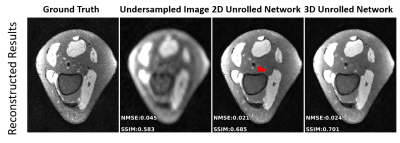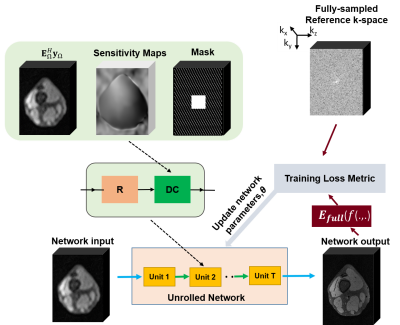Zilin Deng1,2, Burhaneddin Yaman1,2, Chi Zhang1,2, Steen Moeller2, and Mehmet Akçakaya1,2
1University of Minnesota, Minneapolis, MN, United States, 2Center for Magnetic Resonance Research, Minneapolis, MN, United States
1University of Minnesota, Minneapolis, MN, United States, 2Center for Magnetic Resonance Research, Minneapolis, MN, United States
Training of 3D unrolled networks for volumetric MRI
reconstruction with small databases and limited GPU resources may be
facilitated by small-slab processing

Figure 3. A
representative test slice from reconstructions using 2D and 3D unrolled
networks. 2D processing suffers from residual artifacts (red arrows), which are
suppressed with the 3D processing.

Figure 2. Schematic of the supervised training on the small slabs
generated from the volumetric datasets. Unrolled neural networks comprise a
series of data consistency and regularizer units, arising from conventional
iterative optimization algorithms. In this work, we use a 3D unrolled network.
A ResNet architecture with 5 residual blocks, consisting of 2 convolution
layers with former followed by ReLU and latter followed by a scaling layer is
used for implicit regularization. All layers of this ResNet use 3×3×3 kernels
and 64 channels.